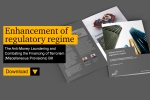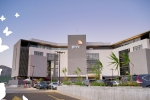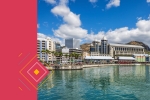
As we reach the end of 2022, COVID-19 may have faded as a headline story, but several other news stories are emerging, from the Russia-Ukraine war, weaker economic growth, stronger inflation as well as the ongoing repercussions of the global pandemic. How did the Mauritius economy do in 2022 and what can we expect in 2023?
Article from Discover & Invest - Issue 23 - December 2022
2022 has been a year of recovery, on the back of the re-opening of the borders in October 2021 together with the relaxation of the COVID-19 health protocols. From January to October 2022, tourist arrivals increased by 1100%, with some 755,000 tourists arriving on the Island, compared to approximately 64,000 for the same period in 2021.
Two years of COVID have left many people desperate to go on holiday and, despite the average global airfares jumping by some 48% in 2022 (according to the Global Business Travel Association), projected tourist arrivals to the end of 2022 remain healthy. The premium leisure market experienced a stronger rebound and, in recent months, hotel occupancy rates in the premium segment have reached or even exceeded pre-pandemic levels.
Looking ahead into 2023, the Economist Intelligence Unit predicts that global tourism will increase by 30% next year, following a growth of 60% in 2022. However, airfares are likely to remain expensive in the short-term (due to less airline capacity and higher inflation) and, with people having less income to spend as well as a global economic downturn, air traffic is expected to remain below pre-pandemic levels. Major economies will go into recession. America’s recession should be relatively mild while, in Europe, it will be more brutal. The pain will be global but, with our main tourist markets severely undermined, the outlook remains challenging.
The projection for 2022 is that the country’s GDP will grow by some 6% against 3.7% in 2021, triggered by the rebound in the tourism sector, and its multiplier effect in the domestic economy. This year, the Mauritian economy is expected to reach its pre-pandemic level for the first time, with a GDP of over MUR500bn. The government’s measures aimed to encourage local manufacturing and consumption, as well as higher export of services, have helped to support growth.
The latest trade statistics show that the country’s trade deficit remains high, and, in August 2022, there was a 45% year-on-year growth in imports due to the low activity levels in prior year, while exports reflected a 16% increase. Given the trade imbalance, the domestic market is experiencing a shortage of foreign exchange, and this is hampering business activities. Surprisingly, the country’s gross official international reserves are at MUR329bn (September 2022), with over 15 months cover on imports.
The inflation trajectory will depend on the supply-side challenges, escalation of the Russia-Ukraine war and the further depreciation of the Rupee.
Based on the above, the global slowdown is expected to soften the country’s performance in 2023, and GDP growth is expected at 5%. Price pressures will remain high and headline inflation is expected to stabilise around 10% for most part of next year. The inflation trajectory will depend on the supply-side challenges, escalation of the Russia-Ukraine war and the further depreciation of the Rupee.
The domestic economy will continue to struggle to cope with labour shortages and wage demands, despite a 26% youth (people below 24 years old) unemployment rate as the labour market faces challenges to absorb those unemployed. Foreign labour is likely to feature more prominently in the years ahead.
The country’s debt to GDP ratio remains high at approximately 85% (South Africa, 67%) and, although lower compared to countries such as the US or the UK (127% and 99% respectively), public finances are under pressure. The Monetary Policy Committee of the Bank of Mauritius raised the repo rate for a fourth successive time, in November 2022, by 100 basis points to 4%.
In line with the recent decisions of the European Central Bank and the US Federal Reserve on interest rates, the Bank of Mauritius is likely to frontload rate increases in 2022 to close cross-border interest rate differentials, whilst containing excess volatility in the foreign exchange market. Robust growth in 2022 has allowed space for tighter monetary policy to tackle inflation as well as narrowing the interest rate spread. The expectation for 2023 is that there may be further interest rate increases (up to 100 basis points) and thereafter the repo rate will hold.
Private consumption will start fluttering with elevated inflation in 2023. Debt exposure to household appears substantial, with a 38% households’ loan-to-GDP ratio. Most low-income households are indebted due to the purchase of consumer durables on a short-term basis, whilst higher income families take out longer-term housing loan. The government’s measures in terms of increases in social benefits, food subsidies and continued price controls for staple food will mitigate the impact of inflation on consumer activity.
However, with interest rates rising, the population will feel the pressure of tightening monetary policy, contracting real incomes, and debt servicing costs. These factors will force consumers to pull back on discretionary spending and focus on basic essentials. Unsurprisingly, those in lower paid jobs will struggle more; the minimum wage will not be sufficient to afford the cost of essentials and poverty will be on the rise.
A question mark remains as to whether the extension to Côte d’Or is really necessary at this stage.
Road and infrastructure projects have been dominant in recent years and will continue to feature prominently in 2023. The annual cost of congestion is estimated at MUR4bn annually and the current vehicle population stands at just over 620,000 vehicles. The Metro-Express has been a real game changer to the local transport network, with its initial launch in 2020 and phase 2 becoming fully operational in October 2022. The average ridership during phase 1 was at 17,000 per day and at the end of 2021, the Metro Express carried over 5 million passengers.
However, despite its successful launch, the Metro Express recorded a loss of MUR500m for the financial year 2020-21 and much of its financial health relies on the Curepipe-Port Louis corridor passenger flows as well as a modal shift from cars to the metro. In addition to the operational losses, the Metro Express will need to repay loans totalling over MUR1bn granted by the government and, although passenger traffic will increase significantly with phase 2, it will be difficult to break even on ridership alone.
The government is also securing a new credit line of USD300m for the extension from Rose Hill to Réduit to Côte d’Or. Whilst the viability of the Metro Express project should be assessed in a broader context (to consider urban regeneration, terminals and mini commercial hubs), a question mark remains as to whether the extension to Côte d’Or is really necessary at this stage.
The Metro Express runs on electricity and it is important to increase the penetration of locally generated renewable energy. The government targets 60% energy from renewable sources by 2030 and this should create new investment pathways. Whilst new tax incentives to promote green technologies have been introduced, investor-friendly regulations as well as affordable access to finance would help to push for faster adoption. As a small island state, renewable energy can help build more resilience and have a positive impact on economic growth. The transition of the Island into a green economy is an important pillar to foster sustainable development for the country.
Smart cities are also influencing the economic development. Since 2015, many projects have been launched and are now well progressed, including in Beau-Plan, Medine, Moka, Mont Choisy, Tamarin, etc. These projects are redefining and modernising the landscape of Mauritius as well as the way we work and live. Those smart cities are also helping to boost the construction sector, create jobs and attract Foreign Direct Investments (‘FDI’) into the country.
Real estate continues to be a significant source of FDI; in the first quarter of 2022, gross FDI flows into real estate activities amounted to approximately MUR2.7bn and represented just over 55% of all FDI flows into the country. Europe accounted for 43% of total inflows. We can expect similar trends in 2023 but the country’s lack of investment opportunities remains a concern for the future.
As in 2022, the world in 2023 will remain fickle and unpredictable. The country is still riding the wave of the post-pandemic recovery and let’s hope that the global economic slowdown will be short-lived.
















